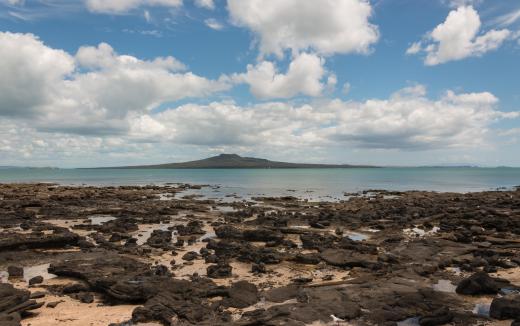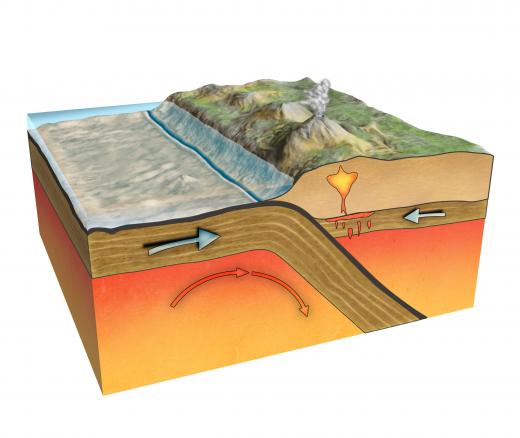What are Ocean Trenches?
Ocean trenches are chasms or depressions in the ocean floor. They are usually narrow but extremely deep, reaching some of the lowest below sea level points ever discovered. These trenches are formed at subduction zones, which mark the boundaries of lithospheric plates.
The Earth’s lithospheric layer includes the upper mantle and the crust, or surface. All of the planet’s water and land is found on the lithosphere. This layer is not one entire mass, but a congregation of different slabs, called plates. These plates are huge and can be the bedrock of entire oceans and continents. The study of these lithospheric plates and their movement is called plate tectonics, a main theoretical field of geology.

There are three main types of boundaries where these plates meet. Transform boundaries are where plates move past each other, divergent boundaries are where plates move away from each other, and convergent boundaries are where one plate slides beneath another. Ocean trenches are formed at convergent boundaries, called subduction zones, which are usually the center of a lot of tectonic activity.

Trenches in the ocean are commonly found parallel to volcanic islands. This is often due to dehydration reactions, which occur when an underlying plate sinks beneath an upper one. This movement often causes water to make contact with hot mantle from under the lithosphere, and the resulting chemical reaction creates a land mass. Volcanoes and chains of volcanic islands, called volcanic arcs, are formed when the lava is released and builds up above the water line.

The Mariana Trench, located near Japan in the Pacific Ocean, is the deepest ocean trench. It is also the deepest point in the Earth’s surface, reaching depths of 36,201 feet (11,033 meters). This means it is bigger than Earth’s highest point, Mount Everest, which measures 29,035 feet (8,850 meters). The deepest point of the Mariana Trench, called the Challenger Deep, was named after HMS Challenger II, the British exploration vessel that first reached that depth in 1960.

Aquatic life thrives even in these trenches, which are deprived of almost any sort of light and under extreme pressure. A number of diverse species, ranging from microorganisms like bacteria to jellyfish, lobsters, and octopi, have been found in them. A sample of dirt taken from the Challenger Deep even showed signs of foraminifera, which are single-celled organisms resembling some of the earliest life forms discovered on Earth.
AS FEATURED ON:
AS FEATURED ON:














Discussion Comments
@Amphibious54- A few different types of currents circle the oceans. I cannot say this for sure, but your assumption about ocean trenches having an effect on the currents is probably right. The deepest parts of the ocean would have an effect on the deep ocean currents that exist due to density changes.
From what I can remember from geology, the thermohaline currents follow the ocean trenches because they are the deepest point where the cold, dense water accumulates. This is also the reason that the ocean trenches are the coldest place on earth.
If my memory serves me correctly, the sun heats the surface water, which sits on the top. As the water reaches the poles, it cools and begins to sink. This cold water then gets pushed along the trenches until it warms in the Pacific and Indian oceans, losing density and rising to the surface, the cycle then repeats itself in perpetuity.
What effect do the ocean trenches have on ocean currents? It seems like the large trenches in below the sea's surface would have a big impact on the way that currents run and the types of ecosystems in the ocean. Do ocean currents run parallel to the trenches?
Are they so cold because they are the coldest part of the thermohaline cycle? I would be interested in learning a little more about the effect that ocean trenches have on currents.
@Oceana - That is very interesting! I would have thought that with all of that volcanic activity nearby, the trench would be fairly warm!
I read that the Mariana Trench is one of the coldest regions in the world. The temperatures there fall between 34 and 39 degrees Fahrenheit.
Deep sea life fascinates me. It amazes me how any creature could withstand the extreme amount of pressure in an ocean trench.
I read that a team of scientists exploring the Peru-Chile trench, located in the Southeast Pacific, found an entirely new species of snailfish there at a depth of 7000m. Along with the snailfish, they found cusk-eels and big crustacean scavengers, called amphipods. Scientists didn’t know that such a large number of them lived that deep in the trench.
One group of these are called Eurythenes. These shrimp-like scavengers were the biggest ever found to live at such a depth.
Post your comments